As soon as I entered Chihuly Garden and Glass exhibit, the notion of camera panning grabbed my attention and wouldn't let go. I approach camera panning by varying the exposure time and camera movement. Each subject has a different exposure time and camera movement. In my vigorous camera shaking, I never considered taking a static image - so I've added images from the Chihuly website for your reference (below). I'm sure you can figure out which images match up. To learn how to create images like these, consider attending one of my nature photography workshops in Acadia National Park.
Glass Waves (top): Nikon D800, 24mm, f/9, 1 sec, ISO 800, 3/30/15, 6:30 PM
Glass Petals (bottom): Nikon D800, 42mm, f/9, 1/4 sec, ISO 800, 3/30/15, 6:43 PM
Glass Waves, Ghihuly Garden and Glass, Seattle, WA
Glass Petals, Ghihuly Garden and Glass, Seattle, WA
Photos from the Chihuly website of the same subjects, for your reference.
Chihuly Glass Forest, Seattle, WA
Chihuly Persian Ceiling, Seattle, WA




